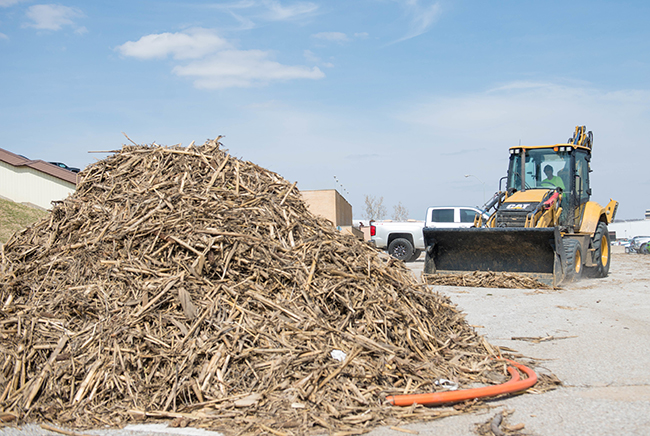
Charles Cswercko, 55th Civil Engineer Squadron pavement and equipment operator, clears flood debris near building 500 to build a temporary parking lot March 27, 2019, at Offutt AFB, Neb. Air Force photo by Zachary Hada.
Managing the effects of natural disasters and updating antiquated buildings top the list of Air Force-related concerns in the House Appropriations military construction, veterans affairs subcommittee’s fiscal 2020 spending bill, which lawmakers approved May 9 with a vote of 31-21.
The $108 billion legislation would allocate $1.6 billion to Air Force MILCON, about $150 million higher than the service received in 2019, but $590 million less than the service asked for in the upcoming year. Nearly $736 million is tagged for Air Force construction, planning, and design projects related to last year’s Hurricanes Florence and Michael.
While House and Senate appropriators ultimately have to agree on a final number, their considerations come as the Air Force faces a multibillion-dollar shortfall to restore bases damaged by recent hurricanes and floods. The service also recently proposed a pricey, long-term infrastructure improvement program.
Work needed to house fighter jets at new locations will account for about one-third of total spending in 2020, according to the report accompanying the bill. Building F-35A facilities at Tyndall AFB, Fla., is expected to cost $350 million, and it will cost $150 million to bring new training and operational squadron facilities to existing F-22 bases as the Raptors relocate from Tyndall.
“The Air Force is still determining what additional facilities would be required for the additional three squadrons,” the committee report said of Tyndall’s new F-35s, slated to arrive in late 2023. “It would not be prudent to have fifth-generation air assets like the F-35 housed in inappropriate hangars that fail to protect the aircraft from the elements.”
Lawmakers on the Democrat-led committee pointed to Tyndall, which was decimated by Category 5 Hurricane Michael last October, as a prime example of why the Defense Department should boost its preparation for “inevitable future disasters” at coastal military installations and housing facilities. Severe drought and desertification elsewhere should also be a top concern.
“In addition to department-wide initiatives, such as revised structure planning, conservation programs, and modeling new installations with the threat of sea level rise in mind, the committee encourages DOD to prioritize investing in climate-sustainable infrastructure projects,” according to the report. “Such investments have yielded positive results including increased resiliency and cost savings.”
University researchers can help the Pentagon better understand how vulnerable DOD installations are, and to test building techniques that can stand up to 200 mph winds, storm surges, and flooding, lawmakers argue.
They also used the report to voice support for Offutt AFB, Neb., and its strategic assets after storms flooded one-third of the base in March. During markup, members adopted an amendment introduced by Rep. Jeff Fortenberry (R-Neb.) to add $300 million in emergency funding to repair or replace Offutt facilities.
The Omaha World-Herald reported May 2 that the Air Force now needs $420 million to clean up Offutt and replace about 60 irreparably damaged structures, including 55th Wing headquarters. Earlier this year, the service estimated it needed $350 million for support and facilities sustainment, restoration, and modernization at the base.
Elsewhere in the bill, lawmakers raised concerns about the state of Air Education and Training Command facilities and worried combat readiness may suffer.
“The committee recognizes the adverse impact that flooding and other infrastructure challenges have had on AETC facilities, equipment, operations, and training,” the report added. “The committee also recognizes the steps that the Air Force has taken to begin mitigating the damage through multi-year projects. The committee supports these efforts and urges the Secretary of the Air Force to prioritize these projects.”
The bill also recommends the Air Force pay more attention to antiquated air traffic control towers that contain mold, asbestos, and lead-based paint, and that in some cases block the view of aircraft taxiing and landing.
Lawmakers requested a string of reports to be delivered once the bill becomes law. Those would:
- Detail the Pentagon’s plans to “develop lasting and resilient military installations, and what year these projects will appear” in five-year spending plans, within 180 days after enactment;
- Explain how much it will cost to build weather-resilient F-35 beddown facilities at Tyndall, and when and where that will happen, within 60 days after enactment;
- Provide the cost, location, and year of MILCON projects needed to relocate the F-22s from Tyndall, within 60 days after enactment;
- Describe “the process and formulas [the Air Force] uses to prioritize its infrastructure renovation and upgrade projects” for dormitories, within 60 days after enactment;
- Assess the risk posed by Reserve component hangars damaged in natural disasters, along with a facilities improvement plan between 2021-2025, within 60 days after enactment.
“Many of the Air Force Reserve hangars that were damaged during the record-breaking 2017 hurricane season are unsafe, antiquated, and do not provide adequate protection of Air Force Reserve air assets,” the report noted. “Hangars located at Homestead Air Reserve Base [Fla.] have become wholly inadequate due to constrained military construction budgets and devastating storm damage, and are putting equipment and air assets at risk. … This could be a problem throughout the Air Force Reserve enterprise with the recent reductions to DOD’s construction accounts.”
Under the House legislation, the Reserve would receive about $60 million for MILCON. Air Force family housing would also get about $430 million split between operations and maintenance and construction funds, and the service’s piece of European Deterrence Initiative facilities projects would be $437 million.
